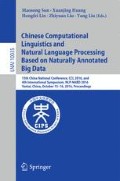Abstract
Neural network based Chinese Word Segmentation (CWS) approaches can bypass the burdensome feature engineering comparing with the conventional ones. All previous neural network based approaches rely on a local window in character sequence labelling process. It can hardly exploit the outer context and may preserve indifferent inner context. Moreover, the size of local window is a toilsome manual-tuned hyper-parameter that has significant influence on model performance. We are wondering if the local window can be discarded in neural network based CWS. In this paper, we present a window-free Bi-directional Long Short-term Memory (Bi-LSTM) neural network based Chinese word segmentation model. The model takes the whole sentence under consideration to generate reasonable word sequence. The experiments show that the Bi-LSTM can learn sufficient context for CWS without the local window.
Access this chapter
Tax calculation will be finalised at checkout
Purchases are for personal use only
References
Berger, A., Pietra, S.D., Pietra, V.D.: A maximum entropy approach to natural language processing. Comput. Linguist. 22(1), 39–71 (1996)
Chen, X., Qiu, X., Zhu, C., Liu, P., Huang, X.: Long short-term memory neural networks for Chinese word segmentation. In: Proceedings of the Empirical Methods in Natural Language Processing (2015)
Chen, X., Qiu, X., Zhue, C., Huang, X.: Gated recursive neural network for Chinese word segmentation. In: Proceedings of Annual Meeting of the Association for Computational Linguistics (2015)
Collobert, R., Weston, J., Léon, B., Michael, K., Koray, K., Pavel, K.: Natural language processing (almost) from scratch. J. Mach. Learn. Res. 1, 1–48 (2011)
Hochreiter, S., Schmidhuber, J.: Long short-term memory. Neural Comput. 8(9), 1735–1780 (1997)
Lafferty, J., McCallum, A., Pereira, F.C.N.: Gated recursive neural network for Chinese word segmentation. In: Proceedings of Annual Meeting of Eighteenth International Conference on Machine Learning (2015)
Mansur, M., Pei, W., Chang, B.: Feature-based neural language model and Chinese word segmentation. In: Proceedings of International Joint Conference on Natural Language Processing (2013)
Pei, W., Ge, T., Chang, B.: Max-margin tensor neural network for Chinese word segmentation. In: Proceedings of Annual Meeting of the Association for Computational Linguistics (2014)
Peng, F., Feng, F., McCallum, A.: Chinese segmentation and new word detection using conditional random fields. In: Proceedings of International Conference on Computational Linguistics (2004)
Emerson, T.: The second international Chinese word segmentation bakeoff. In: Proceedings of the Fourth SIGHAN Workshop on Chinese Language Processing, pp. 123–133 (2005)
Xue, N.: Chinese word segmentation as character tagging. Comput. Linguist. Chinese Lang. Process. 8(1), 29–48 (2003)
Xue, N., Xia, F., Chiou, F.D., Palmer, M.: The Penn Chinese TreeBank: phrase structure annotation of a large corpus. Natural Lang. Eng. 11(2), 207–238 (2005)
Yang, Y., Xue, N.: Chinese comma disambiguation for discourse analysis. In: Proceedings of Annual Meeting of the Association for Computational Linguistics (2012)
Zheng, X., Chen, H., Xu, T.: Deep learning for Chinese word segmentation and POS tagging. In: Proceedings of the Empirical Methods in Natural Language Processing (2013)
Acknowledgments
The research is supported by National Natural Science Foundation of China (Contract 61202216). Liu is partially supported by the Science Foundation Ireland (Grant 12/CE/I2267 and 13/RC/2106) as part of the ADAPT Centre at Dublin City University. We sincerely thank the anonymous reviewers for their thorough reviewing and valuable suggestions.
Author information
Authors and Affiliations
Corresponding author
Editor information
Editors and Affiliations
Rights and permissions
Copyright information
© 2016 Springer International Publishing AG
About this paper
Cite this paper
Zhang, J., Meng, F., Wang, M., Zheng, D., Jiang, W., Liu, Q. (2016). Is Local Window Essential for Neural Network Based Chinese Word Segmentation?. In: Sun, M., Huang, X., Lin, H., Liu, Z., Liu, Y. (eds) Chinese Computational Linguistics and Natural Language Processing Based on Naturally Annotated Big Data. NLP-NABD CCL 2016 2016. Lecture Notes in Computer Science(), vol 10035. Springer, Cham. https://doi.org/10.1007/978-3-319-47674-2_37
Download citation
DOI: https://doi.org/10.1007/978-3-319-47674-2_37
Published:
Publisher Name: Springer, Cham
Print ISBN: 978-3-319-47673-5
Online ISBN: 978-3-319-47674-2
eBook Packages: Computer ScienceComputer Science (R0)

